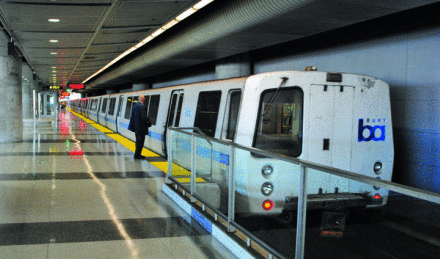|
A major improvement to the interior of the new cars is the new seats and seating arrangement. There are wider handholds on top of each seat and smooth new seat coverings. In addition, the new seats have more room underneath for service animals or carry-on luggage.
Although there are fewer seats per carriage than in the old cars, BART is planning to increase the fleet size from 669 currently to 1,081, and to modernize the train control system to run trains more frequently. The net effect is expected to be 49% more seats available in the BART system.
The new cars have three sets of doors on each side instead of two sets. This will provide for faster loading and unloading of the trains.

In the older carriages, the heating, ventilation, and air-conditioning (HVAC) duct system is placed underneath the floor. The cool air is directed to the seat by the window. The design was based on most passengers having seats. People standing were expected to be quite rare. Today, however, there are many who must stand, and those travelers do not receive much cool air.
Although the HVAC system on the new train cars is housed under the floor, the fresh air is distributed from the carriages’ ceiling, providing better air flow throughout the interior. The heating and cooling systems on the new trains have state-of-the-art climate control technology that is not only more comfortable but more energy efficient.
In addition to an aluminum exterior, which reflects light to help keep cars cool, the new carriages have a white roof to further deflect heat away from the passenger compartment.
Full article: IEEE Vehicular Technology Magazine, Volume 14, Number 1, March 2019 |